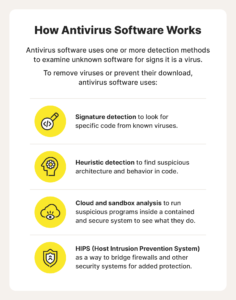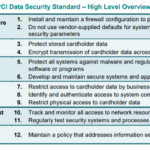In this article, we will explore the exciting possibilities and potential future advancements in antivirus technology. As our digital landscape becomes increasingly robust and complex, the need for advanced cyber security measures becomes paramount. We will delve into the innovative approaches being considered to tackle evolving cyber threats and how these developments could shape the future of antivirus technology. So, grab a cup of coffee, and let’s dive into the fascinating world of antivirus technology and its potential to safeguard our online experiences.
The Growth of Artificial Intelligence and Machine Learning
In recent years, the growth of Artificial Intelligence (AI) and Machine Learning (ML) has had a profound impact on antivirus technology. AI and ML have revolutionized the way antivirus systems detect and respond to threats, making them more intelligent and effective.
Role of AI and ML in antivirus developments
AI and ML play a crucial role in antivirus developments by enabling the systems to learn and adapt to new threats. Traditional antivirus systems relied on signature-based detection, which involved matching known virus signatures. However, this approach was limited because it couldn’t detect new or unknown threats.
With AI and ML, antivirus systems can analyze vast amounts of data and learn to identify patterns and anomalies associated with known and unknown threats. This allows them to proactively detect and mitigate emerging threats, providing a higher level of protection for users.
Possibilities for AI-ML based detection and pre-emption of threats
The integration of AI and ML in antivirus systems opens up exciting possibilities for proactive threat detection and pre-emption. By analyzing large datasets in real-time, AI-ML driven antivirus systems can identify subtle changes in behavior and detect potential threats before they have a chance to wreak havoc.
For example, AI-ML algorithms can recognize patterns of malicious code execution and block it before it can cause harm. Additionally, these systems can leverage historical data and user behavior to identify suspicious activities and potential threats, providing a more proactive approach to cybersecurity.
Current limitations of AI and ML in antivirus systems
While AI and ML offer significant advancements in antivirus technology, there are still limitations that need to be addressed. One challenge is the possibility of false positives or false negatives. AI-ML algorithms may sometimes wrongly classify legitimate files as threats or fail to detect sophisticated attacks.
Furthermore, AI-ML systems heavily rely on data quality and quantity. If there is insufficient or biased data available, it can lead to inaccurate predictions and compromised security. Additionally, the constant evolution of cyber threats requires regular updates and training of AI-ML models to ensure maximum effectiveness.
Despite these limitations, the continuous advancements in AI and ML hold great promise for the future of antivirus technology, making systems more robust and resilient against evolving cyber threats.
Increased Focus on Predictive Analysis
As the volume of data in the digital landscape continues to grow exponentially, antivirus technology is looking towards predictive analysis as a key component in tackling cyber threats.
Using big data for predictive analysis
Big data has become an essential resource for antivirus systems to improve threat detection and response. By analyzing large datasets from various sources, such as network traffic, user behavior, and threat intelligence feeds, antivirus systems can identify recurring patterns and potential indicators of compromise.
This predictive analysis enables antivirus systems to anticipate and respond to threats more effectively, reducing the overall risk of a successful cyber attack.
Potential to identify new threats through predictive models
Predictive analysis has the potential to identify new and emerging threats that traditional antivirus systems may miss. By analyzing historical data and utilizing machine learning algorithms, antivirus systems can detect subtle changes in patterns that indicate the presence of previously unknown threats.
This proactive approach allows antivirus systems to stay one step ahead of cybercriminals and protect users from evolving threats.
Prospects for improved cyber incident response with predictive analysis
Predictive analysis not only enables early threat detection but also enhances the incident response capabilities of antivirus systems. By leveraging real-time data analysis and machine learning algorithms, antivirus systems can rapidly assess the severity and impact of a cyber attack, facilitating faster and more effective incident response.
By automating key incident response processes, such as containment and remediation, antivirus systems help minimize the damage caused by cyber attacks, allowing organizations to recover quickly from security breaches.
Predictive analysis holds great promise in strengthening antivirus technology’s ability to detect, prevent, and respond to cyber threats with greater accuracy and speed.
Integration of Antivirus with Other Security Tools
In an increasingly complex and interconnected digital landscape, the integration of antivirus technology with other security tools has become crucial to address the evolving nature of cyber threats.
Increasing importance of security system integration
Cyber threats are becoming more sophisticated, often requiring a multi-layered approach to detection and prevention. Therefore, integrating antivirus technology with other security tools, such as intrusion detection systems, firewalls, and threat intelligence platforms, is essential to create a comprehensive defense against cyber attacks.
This integration enables security tools to share data and collaborate, providing a holistic view of potential threats and enabling faster, more effective incident response.
Possible developments in integrated security platforms
The future of antivirus technology lies in the development of integrated security platforms that seamlessly combine multiple security tools into a unified system. These platforms would leverage AI and ML to analyze data from various sources and provide real-time threat intelligence to all interconnected security tools.
This integration allows for more accurate and dynamic threat detection, faster response times, and improved security posture for organizations.
Benefits of antivirus compatibility with other security tools
The compatibility of antivirus technology with other security tools brings numerous benefits to organizations. Firstly, it enhances the overall threat visibility by leveraging combined intelligence from various security tools. By sharing data, antivirus systems can enrich their knowledge base, improving their ability to detect and mitigate threats.
Secondly, integration with other security tools enables more coordinated incident response efforts. When multiple security tools work together, they can efficiently exchange information and automate response actions, resulting in faster containment and mitigation of cyber threats.
The seamless integration of antivirus technology with other security tools is a vital aspect of future antivirus developments, ensuring comprehensive protection against evolving cyber threats.
Development of Advanced Heuristic Techniques
In the face of constantly evolving cyber threats, the development of advanced heuristic techniques is crucial to ensure effective detection and prevention of sophisticated attacks.
The importance of heuristics in antivirus technology
Heuristic techniques play a critical role in antivirus technology by enabling the detection of previously unknown threats that cannot be recognized through signature-based methods. Heuristics analyze the behavior and characteristics of files and programs to identify suspicious or malicious patterns.
By using heuristic analysis, antivirus systems can detect and block threats based on their behavior rather than relying solely on predefined signatures, providing a more proactive approach to security.
Potential advancement and refinement of heuristic techniques
The advancement and refinement of heuristic techniques have the potential to significantly enhance antivirus technology’s ability to detect and prevent emerging threats.
By leveraging AI and ML algorithms, antivirus systems can continuously learn and adapt to new attack methodologies, improving their ability to identify and block evolving threats. This approach allows antivirus systems to stay ahead of cybercriminals and protect users from rapidly evolving attack vectors.
Furthermore, the combination of behavioral analysis, machine learning, and threat intelligence can enable antivirus systems to identify advanced evasion techniques employed by sophisticated attackers, further strengthening their detection capabilities.
Threats that might be addressed by future heuristic developments
Future heuristic developments hold great promise in addressing emerging threats, such as fileless malware, zero-day exploits, and polymorphic malware.
Fileless malware, which operates entirely in memory without leaving traces on disk, poses a significant challenge to traditional antivirus systems. However, advanced heuristic techniques can detect malicious activities in real-time, even if the malware does not exhibit typical file-based behavior.
Zero-day exploits and polymorphic malware, which constantly change their characteristics to evade detection, can also be countered by heuristic analysis. By focusing on the behavior and intent of files and programs rather than static signatures, antivirus systems can detect and prevent these sophisticated threats.
The continuous enhancement of heuristic techniques will play a crucial role in antivirus technology’s ability to address evolving cyber threats effectively.
The Role of Quantum Computing
Quantum computing has the potential to revolutionize many areas of technology, including antivirus systems. However, it also presents unique challenges and considerations for the cybersecurity community.
Implications of quantum computing on antivirus technology
Quantum computing can potentially break traditional encryption algorithms that are currently used to protect sensitive data and communication channels. This could render many existing antivirus systems and security measures obsolete.
However, quantum computing can also offer opportunities for enhancing antivirus technology. Quantum algorithms could be used to improve the efficiency and effectiveness of threat detection and analysis, enabling antivirus systems to process vast amounts of data at unprecedented speeds.
Potential hurdles and opportunities in quantum-based antivirus systems
One of the main hurdles in developing quantum-based antivirus systems lies in the practical implementation of quantum computing. Quantum computers are still in their early stages of development and face significant technical challenges to achieve stability and scalability.
However, if these challenges are overcome, quantum-based antivirus systems could provide unparalleled threat detection capabilities. Quantum algorithms could enable antivirus systems to rapidly analyze complex patterns, identify new attack vectors, and develop advanced defenses against emerging threats.
Dealing with quantum threats using quantum computing
As quantum computing advances, so does the need for quantum-resistant cryptography to protect sensitive data from potential future attacks. Antivirus systems will need to adapt and utilize quantum-resistant encryption algorithms to ensure the confidentiality and integrity of data in the face of quantum-enabled threats.
Additionally, quantum-based antivirus technology could leverage quantum machine learning algorithms to analyze massive datasets more efficiently, enabling faster and more accurate threat detection.
While still in its infancy, quantum computing holds immense potential for antivirus technology, paving the way for more robust and resilient systems to address evolving cyber threats.
Evolution of Signature-Based Detection Methods
While signature-based detection has been the cornerstone of antivirus technology for decades, its limitations have become increasingly evident in the face of evolving cyber threats.
Limits of current signature-based detection
Signature-based detection relies on comparing files and programs against a database of known virus signatures. However, this approach struggles to detect new and unknown threats that do not have a predefined signature.
This limitation is further exacerbated by the rapid proliferation of malware variants and the continuous evolution of attack techniques. Traditional signature-based detection struggles to keep up with the sheer volume and diversity of new threats, creating a gap in protection for users.
Possible future direction for signature-based threat detection
The future of signature-based threat detection lies in the development of more advanced and dynamic signature databases. Antivirus systems can leverage AI and ML algorithms to automatically generate and update signatures based on behavioral patterns and characteristics observed from known threats.
Additionally, the integration of signature-based detection with other advanced detection techniques, such as heuristic analysis and predictive analysis, can provide a multi-layered defense against emerging threats.
By combining the strengths of signature-based detection with other methods, antivirus systems can improve their detection rates while minimizing false positives and false negatives.
Problems that advanced signature-based detection could solve
Advanced signature-based detection has the potential to address several challenges faced by traditional signature-based systems. By continuously updating and expanding the signature database, antivirus systems can detect the latest malware variants and emerging threats more effectively.
Furthermore, dynamic signature generation based on behavioral patterns can help detect malware mutations and polymorphic malware that attempt to evade detection by altering their signatures.
The evolution of signature-based detection methods is crucial to ensure the ongoing effectiveness of antivirus technology in the face of evolving cyber threats.
Increase in IoT and Mobile Security
With the rapid growth of Internet of Things (IoT) devices and the ubiquity of mobile devices, the importance of antivirus technology in protecting these endpoints has become paramount.
Growing importance of IoT and mobile security in antivirus technology
IoT devices, ranging from smart home appliances to industrial control systems, are increasingly being connected to the internet, introducing new attack vectors and vulnerabilities. Similarly, mobile devices have become integral to our personal and professional lives, making them a prime target for cybercriminals.
Antivirus technology plays a crucial role in safeguarding IoT and mobile devices from malware, data breaches, and unauthorized access. It provides a critical defense layer, ensuring the integrity, confidentiality, and availability of sensitive information and services.
Potential developments in antivirus systems for IoT and mobile devices
Future developments in antivirus systems for IoT and mobile devices will focus on addressing the unique challenges posed by these endpoints.
For IoT devices, antivirus technology needs to adapt to the resource-constrained nature of these devices and potential limitations in connectivity. Lightweight antivirus solutions that consume minimal resources while providing effective threat detection and prevention will be crucial.
In the case of mobile devices, antivirus systems will need to keep up with the evolving techniques used by mobile malware, such as app-based attacks and social engineering. Machine learning algorithms can continuously analyze app behavior and user interactions to detect and block malicious activities on mobile platforms.
Addressing IoT and mobile-based cyber threats with new antivirus technology
By providing real-time threat detection and prevention for IoT and mobile devices, antivirus technology can help mitigate the risks associated with these platforms.
Securing IoT devices prevents them from being compromised and used as entry points into larger networks. It also safeguards sensitive data and ensures the uninterrupted functionality of critical infrastructure systems.
For mobile devices, antivirus technology protects against malware infections, data breaches, and unauthorized access to personal or corporate information. This allows users to confidently use their devices without compromising their privacy and security.
The development of antivirus systems tailored specifically for IoT and mobile devices ensures that these endpoints are protected against the evolving cyber threats they face.
Emphasis on Cloud-Based Antivirus Solutions
Cloud computing has revolutionized the way we store, access, and process data. Antivirus technology has also embraced the cloud, offering a range of benefits and possibilities.
Merits and demerits of cloud-based antivirus solutions
Cloud-based antivirus solutions offer several advantages over traditional, locally installed solutions.
Firstly, cloud-based antivirus systems can leverage the collective intelligence and threat data from a vast network of users, allowing for real-time threat intelligence and quicker updates to protect against emerging threats.
Secondly, cloud-based solutions offload the resource-intensive tasks, such as scanning and analysis, to the cloud servers. This reduces the impact on local system performance, enabling seamless protection without sacrificing usability.
However, the reliance on cloud connectivity introduces potential concerns about data privacy and dependence on external infrastructure. It is crucial to ensure that sensitive user data is adequately protected and that service availability is maintained even during internet outages or disruptions.
Expectations for developments in cloud-based antivirus technology
Future developments in cloud-based antivirus technology will focus on enhancing threat detection accuracy, improving scalability, and strengthening privacy and data protection measures.
Advancements in AI and ML algorithms will enable cloud-based antivirus systems to provide more accurate and dynamic threat detection, minimizing false positives and false negatives.
Improved scalability will allow cloud-based systems to handle the ever-increasing volume of data and users without compromising performance. This will ensure that users can benefit from real-time threat intelligence without experiencing slowdowns or delays.
Privacy and data protection will also be prioritized, with measures in place to ensure that sensitive user data is encrypted, stored securely, and only used for legitimate security purposes.
Cloud-based antivirus solutions offer flexibility, scalability, and real-time protection, making them a key component in addressing future cyber threats.
Development of Behaviour-Based Detection Systems
Behaviour-based detection systems are gaining prominence in the cybersecurity landscape, offering a proactive approach to threat identification and prevention.
Significance of behaviour-based detection in cybersecurity
Behaviour-based detection focuses on analyzing the behavior of files, programs, and network activities to identify patterns and indicators of malicious intent. This approach allows antivirus systems to detect and block threats based on their behavior, rather than relying on predefined signatures or known patterns.
By considering the intent and actions of files and programs, behaviour-based detection systems can uncover previously unknown threats and provide an additional layer of defense against sophisticated attacks.
Potential advancements in behaviour-based antivirus technology
Future advancements in behaviour-based antivirus technology will involve leveraging AI and ML algorithms to enhance threat detection capabilities.
Machine learning algorithms can continuously analyze vast amounts of data to identify patterns and anomalies associated with malware and malicious activities. This allows antivirus systems to adapt to new attack techniques and preemptively block threats based on their behavioral characteristics.
Furthermore, the integration of threat intelligence feeds and real-time network analysis can provide behavior-based detection systems with up-to-date information about emerging threats, enabling proactive defense against evolving cyber threats.
How improvements in behaviour-based detection could address evolving threats
Behaviour-based detection systems have the potential to address evolving threats by focusing on the fundamental characteristics and actions of malware, rather than relying solely on static signatures.
Advanced behaviour-based detection can detect zero-day exploits, polymorphic malware, and fileless attacks that are designed to evade traditional detection methods. By uncovering the behavior patterns associated with these threats, antivirus systems can block them in real-time, mitigating the risk they pose.
The continuous development of behaviour-based detection systems will ensure that antivirus technology remains effective in identifying and preventing emerging cyber threats.
Investment in Cybersecurity Infrastructure
Investment in cybersecurity infrastructure plays a vital role in the development and advancement of antivirus technology, enabling more robust and effective protection against evolving cyber threats.
Importance of infrastructure in antivirus development
A solid cybersecurity infrastructure is the foundation upon which effective antivirus technology is built. This infrastructure encompasses various elements, including network architecture, hardware resources, threat intelligence feeds, and collaborative frameworks.
Investment in these infrastructure components ensures that antivirus systems have the necessary resources and support to perform their functions optimally. It also creates an environment for ongoing research, development, and innovation in the field of antivirus technology.
Opportunities arising from investment in cybersecurity infrastructure
Investment in cybersecurity infrastructure presents numerous opportunities for antivirus technology to evolve and improve.
By providing adequate hardware resources, organizations can enable the deployment of robust antivirus systems capable of handling the growing volume and complexity of cyber threats.
Furthermore, investment in threat intelligence feeds and collaborative frameworks fosters information sharing and cooperation across the cybersecurity community. This collective intelligence enhances the overall effectiveness of antivirus systems, enabling faster and more accurate threat detection and response.
Investment in research and development initiatives allows antivirus technology to stay ahead of emerging threats by fostering innovation and the exploration of new detection techniques.
Role of enhanced infrastructure in tackling future cyber threats
Enhanced cybersecurity infrastructure plays a critical role in ensuring that antivirus technology remains effective in addressing future cyber threats.
By investing in infrastructure components, organizations can empower antivirus systems to handle advanced and evolving attack methodologies. The robust architecture and resources provided enable antivirus systems to scale effectively and adapt to the changing threat landscape.
Furthermore, enhanced infrastructure promotes collaboration and information sharing within the cybersecurity community. This collaborative approach fosters the development of advanced threat intelligence frameworks, ensuring comprehensive protection against emerging threats.
Investment in cybersecurity infrastructure is essential for antivirus technology to evolve and effectively tackle the increasingly sophisticated and diverse threats encountered in the digital world.
In conclusion, the future of antivirus technology is filled with exciting developments and possibilities. The integration of AI and ML, the emphasis on predictive analysis, the integration with other security tools, the development of advanced heuristic techniques, the potential of quantum computing, the evolution of signature-based detection methods, the focus on IoT and mobile security, the rise of cloud-based solutions, the growth of behaviour-based detection systems, and the investment in cybersecurity infrastructure all contribute to a more resilient and proactive approach to cybersecurity. By continually improving and innovating, antivirus technology can stay ahead of evolving cyber threats, ensuring the safety and security of individuals, organizations, and the digital ecosystem as a whole.







